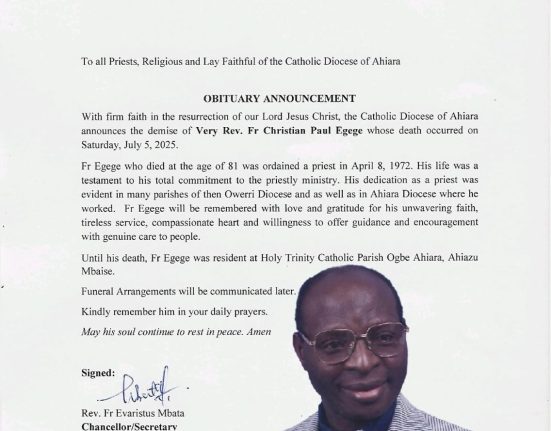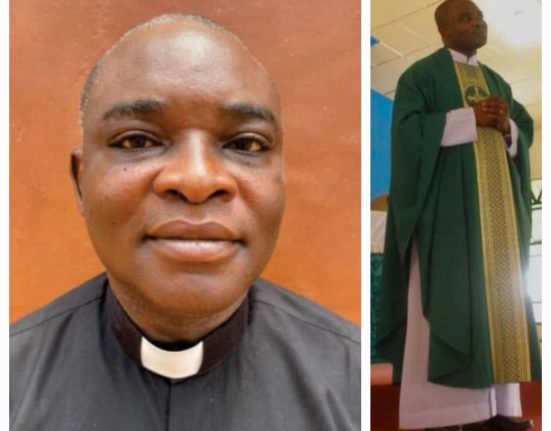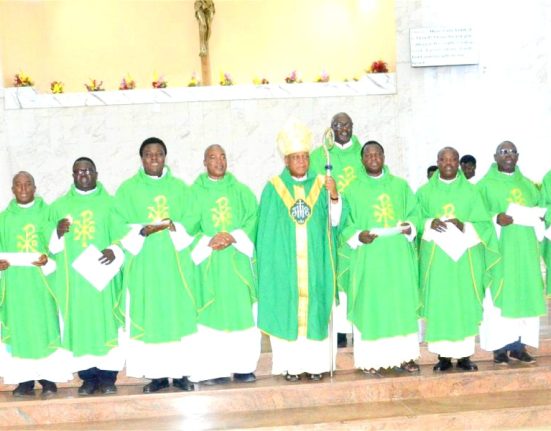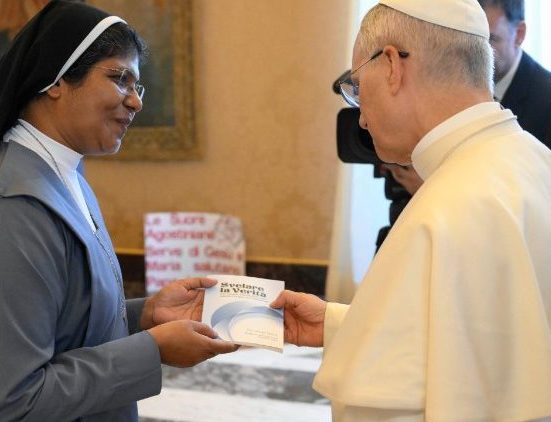Being a Lead Paper delivered at the 34th Theology Week Conference of the Catholic Institute of West Africa (CIWA) in Port Harcourt on 7 April, 2025.
By Rev. Fr. Dr. Michael Nsikak Umoh
Preamble
I am honored to be invited to present this paper. Wondering why such an honour, in the midst of so many erudite scholars, I conclude that the organisers desire that, in my capacity as the National Director of Social Communications of the Catholic Secretariat of Nigeria (CSN), I present a practical or on-the-field contribution on the topic: “Artificial Intelligence and its Impact on Synodality in the Church in Nigeria.” I am therefore very grateful to our revered and indefatigable rector, Very Rev. Fr. Professor Jude Abidemi Asanbe, and to all esteemed members of CIWA academic council, and to the organisers of this laudable academic event for bringing me back home to my alma mater.
This piece is a pastoral communication approach on the topic, with special slant on the mind of the Catholic Bishops Conference of Nigeria (CBCN). By Pastoral Communication, I mean the practical application of communication science, hinging on theological principles, in support of the Church’s evangelisation efforts. In other words, this work is characteristically theological and practical, seeking to provide communication solutions to pastoral initiatives.
Introduction
It is four years now that the Church in Nigeria has joined the universal Church on a synodal journey, seeking to deepen its understanding of communion, participation, and mission. At the same time, a key social factor which is currently affecting every facet of life and therefore cannot be ignored, is the significant changes brought about by Artificial Intelligence. This is capable and responsible for shaping and enhancing the synodal journey. This revolution, Artificial Intelligence (AI), has greatly impacted human interactions, governance, and communication, emerging as one of the most transformative technologies of our time. The Catholic Church in Nigeria is not immune to the far-reaching impacts of technological advancements, societal shifts, and other contemporary developments. As the Church embraces synodality, a journey of communion, participation, and mission, AI presents both opportunities and challenges for fostering collaborative decision-making and inclusive pastoral engagement.
In this paper, we therefore explore the intersection of Artificial Intelligence (AI) and synodality, as we remind ourselves that the Church is not immune to the rapid changes taking place in our world. The Vatican II Fathers said that “The Church is aware that she is not isolated from the world… She is in the midst of the world, and shares its joys and hopes, its griefs and anxieties.” (Second Vatican Council, Gaudium et Spes (1965), no. 4). Pope Benedict XVI corroborates this point, saying that “The Church is not a static entity, but a dynamic reality… She must adapt to the changing circumstances of the world.” (Deus Caritas Est (2005), no. 31).
In the words of Pope Francis, “The Church is called to be a living presence in the midst of the world… She must be attentive to the changes taking place in society.” (Evangelii Gaudium (2013), no. 33). The digital media, especially Artificial Intelligence, are significantly shaping the world today, and therefore should be a source of concern to any discerning mind or institution. The Church must pay serious attention to these changes and explore ways to harness their potential for the advancement of the its mission.
Understanding the Key Concepts
Artificial Intelligence
Artificial Intelligence (AI) has been described as “technology that enables computers and machines to simulate human learning, comprehension, problem-solving, decision-making, creativity, and autonomy” (McCarthy, 2022). This description encompasses not only the traditional aspects of AI, such as learning and problem-solving, but also more advanced capabilities like creativity and autonomy.
In essence, AI refers to the development of computer systems that can perform tasks that typically require human intelligence, but also have the ability to learn, adapt, and make decisions on their own. This includes applications like Natural Language Processing (NLP), Computer Vision, and Generative AI, which enable machines to understand and generate human-like language, recognise and interpret visual data, and create original content like images, videos, and music.
AI systems rely on Machine Learning (ML) and Deep Learning (DL) algorithms to analyse data, learn from experience, and improve their performance over time (Jordan & Mitchell, 2015). These algorithms enable AI systems to automate repetitive tasks, make predictions, and provide insights that can inform decision-making.
AI can be categorized into two main types, Narrow or Weak AI and General or Strong AI (Russell & Norvig, 2010). Narrow AI is designed to perform a specific task, such as facial recognition, language translation, or playing chess (Kurzweil, 2005), while General AI performs any intellectual task that a human can, such as reasoning, problem-solving, and learning (Kurzweil, 2012). AI has far-reaching implications across various sectors. Instances of AI in the area of ccommunication include AI-powered chatbots, virtual assistants, and social media analytics.
Overall, AI has the potential to transform various aspects of our lives, from healthcare and education to transportation and communication (Bostrom & Yudkowsky, 2014); even in our case, religion. Its applications are diverse and continue to expand, making it an exciting and rapidly evolving field.
AI has a multitude of advantages, including increased efficiency, automation of routine tasks, improved productivity, and enhanced decision-making (Davenport & Dyché, 2013). Additionally, it aids in improved accuracy, enhanced precision, improved outcomes, personalised services, intelligent support, and improved engagement (Kaplan & Haenlein, 2019). However, AI also poses significant risks, including job displacement due to automation of jobs, potential unemployment, and social disruption (Ford, 2015). AI systems can perpetuate existing biases, leading to unfair outcomes and discrimination (O’Neil, 2016). AI-powered systems can compromise data security and privacy, leading to potential breaches and exploitation (Pasquale, 2015).
Synodality
Synodality refers to the process of journeying together, as a community of faith, to deepen our understanding of God’s will and to discern our mission in the world (International Theological Commission, 2018). It is characterized by participation, communion, and mission.
Participation
Participation is rooted in the biblical principle of the priesthood of all believers (1 Peter 2:9), which emphasises that every baptized Christian has a role to play in the life and mission of the Church. This underscores Christifideles Laici, a post-synodal apostolic exhortation written by Pope John Paul II in 1988, which emphasises the dignity and vital role of the laity in the Church and their mission to transform the world (John Paul II, 1988). According to the document, the laity are not just an appendage in the Church, or passive recipients of God’s message, but are actively called to participate in the Church’s mission (John Paul II, 1988, n. 33). This point is very crucial in a community that seems neck deep in the hierarchical model.
The preparatory document for the synodal process states: “Participation is the first pillar of synodality … It implies the active involvement of all members of the Church in the life and mission of the Church” (Synod of Bishops, 2021). Participation implies the active involvement and engagement of all members of the Church, regardless of their role or position, in the decision-making process and in the life of the Church. This includes the laity, clergy, and religious, all of whom have a vital role to play in the life of the Church. (Pope Francis, 2013). This element of synodality entails listening to each other’s perspectives and experiences, sharing ideas and insights, collaborating in decision-making processes, and recognising and valuing the diversity of gifts and talents within the Church.
Pope Francis addressed the element of participation in synodality during the 2018 Synod of Bishops on “Young People, the Faith, and Vocational Discernment” and more explicitly in his 2021-2023 synodal process on “For a Synodal Church: Communion, Participation, and Mission.” Also in his 2013 Apostolic Exhortation, Evangelii Gaudium, the Holy Father emphasised the importance of participation in the life of the Church, stating: “The Church is called to be the house of the Father, where there is a place for everyone, with all their problems and difficulties” (Pope Francis, 2013, §47). He also highlighted the need for “a more incisive female presence in the Church” and encouraged women to “participate more in decision-making processes” (Pope Francis, 2013, §103-104). Additionally, in his 2021-2023 synodal process, Pope Francis further emphasised the importance of participation, stating: “The path of synodality is the path that God expects from the Church of the third millennium… A synodal Church is a Church that listens” (Pope Francis, 2021). He therefore encouraged all members of the Church to participate in the synodal process, listening to each other’s perspectives and experiences, and sharing ideas and insights. Thus, the preparatory document for the synodal process emphasises the importance of listening, dialogue, and collaboration in the decision-making process, recognising and valuing the diversity of gifts and talents within the Church. Preparing the world for the synod, Pope Francis’ message for the 2022 World Communications Day focused on the theme “Listening with the ear of the heart” (Francis, 2022). This theme emphasised the importance of listening in communication, dialogue, and relationships, highlighting that listening is a dimension of love and essential for genuine dialogue (Francis, 2022).
Communion
Communion is rooted in the biblical principle of koinonia (2 Corinthians 13:14), which emphasises the importance of fellowship and unity among believers. This refers to the deep sense of unity and bond that exists among members of the Church, despite their differences. In a synodal Church, communion means recognising that we are all part of the mystical Body of Christ (1 Corinthians 12:12-31), while valuing and respecting the diversity of perspectives and experiences that exist within the Church. It also means fostering a sense of mutual support and accompaniment, and celebrating the sacraments, especially the Eucharist, as a source of unity and strength.
Pope Francis notes that synodality is an “essential dimension” of the Church, which is rooted in the communion of the Trinity (EG, 2013). Also, to underscore the importance of communion and synodality in the episcopal ministry, the apostolic constitution, Episcopalis Communio (2018), notes that bishops are called to exercise their ministry in communion with the Pope and with other bishops, and that this communion is an essential aspect of synodality.
Mission
Mission, the third element of synodality, refers to the Church’s fundamental purpose of proclaiming the Gospel and serving the world. It is rooted in the biblical principle of apostleship (Matthew 28:18-20), which emphasises the importance of spreading the Gospel and making disciples of all nations.
In a synodal Church, mission means recognising that the Church exists to serve the world, not just itself (Matthew 28:18-20). It also means embracing a sense of co-responsibility for the Church’s mission and working together to proclaim the Gospel and serve the poor and vulnerable (Pope Francis, 2013). Importantly, mission in synodality also implies being open to new possibilities and challenges in the mission field (International Theological Commission, 2018).
Together, these three elements of synodality (participation, communion, and mission) provide a framework for understanding what it means to be a synodal Church. Participation emphasises the active involvement of all Church members in decision-making and the life of the Church, while communion highlights the importance of unity and mutual support among believers. Mission, the third element, focuses on the Church’s fundamental purpose of proclaiming the Gospel and serving the world, emphasizing co-responsibility and openness to new challenges. From these, we come to understand that synodality is not just a process, but a way of being Church (Pope Francis, 2015). It is a way of living out our faith in communion with one another, and of discerning God’s will for our lives and our communities (International Theological Commission, 2018).
The central questions we must now ask ourselves are: How can AI enhance our understanding and implementation of communion, participation, and mission in the Church? How can AI facilitate more effective communication and collaboration among the faithful? What are the potential risks and challenges associated with the use of AI in the synodal process?
The topic in Nigeria Context
For the Church in Nigeria to effectively embark on the synodal journey, a critical examination of the impact of Artificial Intelligence (AI) on its processes, structures, and relationships is imperative. This is crucial because, as already exposed, AI has the potential to both enhance and undermine the synodal process. On the one hand, AI can facilitate more effective communication, collaboration, and decision-making, while on the other hand, it can also lead to depersonalization, manipulation, and control.
Before we proceed further, it is worth noting that the Catholic Church in Nigeria is actively engaging with the discourse on Artificial Intelligence and encouraging thoughtful consideration of its implications. Archbishop Lucius Iwejuru Ugorji, the President of the CBCN, emphasises the need for “ethical rigor” in approaching AI, highlighting the importance of careful consideration and discernment when embracing and engaging with the technology, and to “handle the issue of Artificial Intelligence with carefulness.” He said, ‘We must strive for a balance that prioritises human welfare alongside technological progress. This requires being mindful of the ethical and moral dilemmas, as well as risks such as job displacement, threat to peace, spread of falsehood, manipulation of the human person, and privacy concerns through advanced hacking and deepfakes.'” (Ugorji, 2024, Keynote Address during 2024 ComWEEK Public Lecture, Abuja).
Therefore, one can say that the Church in Nigeria is aware of the need to approach the use of AI in the synodal process with caution, discernment, and a deep commitment to its values and principles. By doing so, the Church can harness the potential of AI to enhance its mission and ministry, while also avoiding the potential risks and challenges associated with its use. In the context of the Church in Nigeria, synodality is particularly important and relevant because Nigeria is a country with a rich cultural diversity and a strong Catholic presence. By embracing AI for synodality, the Church in Nigeria can build on this tradition and create a more vibrant and missionary Church.
Applicability of Artificial Intelligence to synodality in the Church in Nigeria
From the foregoing, we understand synodality as a process of communal discernment and decision-making in the Catholic Church, which stresses the need for participation, communion, and mission. We have also seen that the key elements of this process include listening to each other’s perspectives, sharing ideas, collaborating in decision-making, and recognising the diversity of gifts and talents in the Church. Furthermore, we noted that the Artificial Intelligence (AI) technology refers to the development of computer systems that can perform tasks that typically require human intelligence, such as learning, problem-solving, and decision-making with greater speed and efficiency; and that this revolutionary technology is immensely applicable to every aspect of human life, including religion.
For the Catholic Church in Nigeria, as a portion of the body of Christ on mission, AI is a valuable tool for fostering participation, enabling the active involvement and engagement of all members in the decision-making process and life of the Church, (particularly within its highly culturally diverse component); for enhancing communion (that deep sense of unity and bond among members which recognises the diversity of perspectives and experiences); and for animating the Mission (the Church’s fundamental purpose of proclaiming the Gospel and serving the world). One can hardly speak of AI application in communications, without referring to social media.
AI technology can be applicable to participation, communion and mission in synodality in the Church in Nigeria in the following ways:
Virtual Meeting Platforms
By creating virtual meeting platforms like WhatsApp, Zoom, Googlemeet and Microsoft Teams, AI-driven meeting platforms can enable proximate and remote participation in meetings, conferences, lectures and discussions, thereby increasing inclusivity and accessibility for participants in both far and near distances. Regarding communion in the Church, though this is not to replace the physical assembly, the virtual channels like satellite TV, YouTube, etc. can facilitate unity in sacramental preparations, devotions and worship, enabling more members to prepare for and participate in celebrating the sacraments in a more meaningful and communal way. This aids the mission of the Church as it fosters evangelisation efforts, since it enables the Church to reach a wider audience and spread the Gospel more effectively. AI-powered digital platforms can facilitate the Church’s service to the poor and vulnerable, as well as be helpful for canvasing for funds, resources, volunteering. They are helpful in advocating for social justice, and for effective sharing of resources, expertise, and responsibilities in carrying out the Church’s mission.
In Nigeria, many priests, religious and lay faithful are already having online pulpits leveraging on AI technology. For instance, also, Bishops Anthony Ewherido and Gerald Musa have their online pulpit through which they connect with thousands of their virtual flock, beyond the confines of their dioceses.
Digital Surveys and Feedback Mechanisms
For all voices to be heard and valued, in the spirit of participation, AI-powered tools can facilitate the creation and distribution of digital surveys, ensuring that all members of the Church have an opportunity to provide feedback and contribute to the decision-making processes. This is very important tool for a church that desires the participation of everyone, irrespective of status or other demographic considerations. Besides the tool aiding creation and distribution of surveys, it also aids to expedite analysing data from large number of participants, ensuring that all voices are heard and valued. When this tool is applied towards mission, data analytics can help the Church monitor and evaluate the impact of its missionary efforts, enabling more effective decision-making, informed action and resource allocation. This is one area we do not seem to do much in Nigeria, not only as it concerns dioceses and parishes, but also in many of our institutions and sodality groups; critical evaluation of missionary initiatives is mostly lacking. Hence there are many institutions today in Nigeria which ostensibly still exist, but are moribund, having lost focus and vision of their primary purpose.
Virtual Channels of Worship
AI-powered virtual platforms can facilitate worship, adoration, prayers, retreats and promotion of pious devotions to different cult of saints. While this will boost number of participation due to power of outreach, it will also promote the mission of evangelisation and a sense of unity and communion. This brings about mutual support and accompaniment among members, promoting a sense of communion and belonging.
Social Media Groups for Community Building
In our experience as Church in Nigeria, more parishes and other institutions are already finding the WhatsApp app to be very helpful in administration and for facilitating information management and communication in their various communities. For parishes and sodalities, the social media are major tools for creating, sustaining and enhancing community, as they enable members to share their experiences, perspectives, and prayers, promoting mutual support and accompaniment.
Natural Language Processing (NLP) for Language Translation
In a country with over 530 languages (NaijaQuest, 2023, List of Languages in Nigeria and States Spoken), AI-powered Natural Language Processing (NLP) and Language Translation and Interpretation are crucial tools for facilitating synodality. These apps enable people overcome the language barriers through real-time language translation, enabling members who speak different languages to participate fully and with ease in exchanging of ideas at conferences, meetings, synodal discussions and decision-making processes. These enhances communication and communion among members who speak different languages. For the mission, this makes communication and collaboration between Church members and communities that speak different languages possible, as well as the translation of texts into the many different languages.
Personalised Communication and Engagement
For participation, AI-powered communication tools help each person to receive and share tailored and structured messages and information according to their specific needs and abilities. This accommodates and takes care of the needs of persons with disabilities, and other different persons bearing in mind their status and demographic considerations. For instance, AI-driven accessibility features, such as text-to-speech functionality, can enable persons with sight impairment to participate fully in synodal activities and decision-making processes. People are also able to engage in study programmes like the bible or online theology/spirituality courses, prayers, and spirituality through personalised guidance and support, which deepen their faith and sense of communion with others.
Virtual Training and Formation Programs
Closely connected to the above point, AI-powered virtual training and formation programs can equip Church members with the skills and knowledge needed to carry out the Church’s mission, including evangelisation, catechesis, and social justice. Overcoming the stress of traveling and physical presence, Virtual Reality and Augmented Reality allows more training and formation with ease, preparing Catholics more deeply with the Church’s mission.
Chatbots and Virtual Assistants
AI-powered Chatbots are useful for research, study, formation, evangelisation and discipleship, archiving, spiritual guidance, etc. They provide resources, guidance and support in these numerous areas, helping members navigate difficult situations and deepening their sense of communion in the Church. These tools include search engines like Magisterium AI, owned by the Catholic Church, active, though still being created. As a follow up to the Communications Week public lecture last year, there are efforts at the national communication office of the Catholic Secretariat of Nigeria (CSN) to build a customised AI-powered chatbots for the Church in Nigeria that can provide Church members and the general public with easy access to authentic information and resources related to the Church in Nigeria, as well as facilitate synodal activities and processes. The first step in this direction is the building of the Nigeria Catholic Digital Data Process (NCDDP) which is currently underway, though slow.
Predictive Analytics for Anticipating Needs
AI-powered predictive analytics can help the Church and organisers of any form of conference or symposium anticipate and prepare for the needs and concerns of Church members and participants, respectively. They will help to ensure high level of participation in decision-making processes that are proactive and responsive. This tool helps in the mission by enabling Church leaders identify areas of need and opportunities for community outreach, enabling more effective planning and resource allocation and promoting a sense of communion and service. Since the Church in Nigeria is not to be closed in on itself, but must relate to the culturally and religiously diverse world around it, social media monitoring and engagement tool enables it to track and respond to online conversations and trends, thereby enabling more effective engagement with the wider world. This too is an important aspect of synodality which AI can effectively aid, if rightly deployed.
Digital Archiving and Storytelling
One big issue we have as a nation is the problem of documentation. Many histories and stories of the Church and missionary efforts are either non-existent or lost due to lack of records or poor storage. This is where AI comes in as AI-powered digital archives and storytelling platforms can preserve and share the stories and experiences of the missionary initiatives of the Church, her pastoral agents and members, promoting a sense of shared history and communion. In fact, AI apps should be deployed to reproduce animated documentaries of some of these stories for storage to aid the present and future generations. This is in the spirit of communion which must connect both the past and present, presenting and preserving the one and same faith and message for all generations, albeit different mediums of telling and sharing the stories.
Steps towards driving the AI for Church engagement
As we gather at this esteemed theology conference, we are reminded that innovative solutions and insightful diagnoses often emerge from such gatherings. However, the true challenge lies not in conceptualizing solutions, but in translating them into tangible actions. With a stellar lineup of experts and thought-provoking topics, this conference presents a unique opportunity to bridge the gap between idea generation and effective implementation. In my view, the 34th CIWA Theology Conference holds profound significance, as it seeks to reignite the synodal conversation that has been a hallmark of our ecclesial landscape in Nigeria. By revisiting this discourse, we aim to distill practical recommendations that will breathe life into the vision and ideals that shape the mission and vitality of the Catholic Church in Nigeria. For this paper to really bear the desired fruits, there are two major arrears I propose that we must pay attention to:
The need to prioritise formation in Artificial Intelligence in our Church Institutions, and
Creating strong awareness on the discrepancy between AI and the hierarchical model in the Church.
Prioritising Formation in Artificial Intelligence
On the need to prioritise formation in Artificial Intelligence in our Church Institutions, one would argue that just as we have the body of Catholic Media Practitioners Association of Nigeria (CAMPAN) and Catholic Artistes and Entertainers Association of Nigeria (CAEAN), the CSN Communication office need to set up a body for Catholics in ICT (Cath-ICT) which will include experts in ICT, AI technology and robotics. The aim of the body would include to explore AI’s potential and develop a strategic plan and manage its application in the mission of the Church. In this same regard, there is the need to conduct AI Awareness and training in all our institutions, educating the youth, church leaders, clergy, and laity about AI’s benefits, limitations, and ethical considerations. The annual Communications Week programme approved by our bishops offers a special platform to implement this and every other form of media literacy campaign at the grass roots in our church. The Church has a grave duty to educate the people on the dynamics and impacts of the media in every age (Pope John Paul II, 1971).
This next recommendation may be subject to debate, similar to my previous suggestion, that the national office develops a media use policy and guideline for the Catholic Church in Nigeria. Such a policy would help enhance and guide the Church’s media culture and facilitate its integration into the Church’s life and mission. Furthermore, it is proposed that the Church deploys AI-Powered tools to build a digital database, capturing pastoral agents, structures, and services in the country. This would enable easy updating, analysis, and informed decision-making.
Finally, on the need to prioritise formation in Artificial Intelligence in our church institutions, it is highly recommended that media syllabus should be developed for all institutions and pastoral agents in Nigeria, according to their peculiar needs. This task may be handled by the Centre for the Study of African Culture and Communication (CESACC) under the guidance and direction of the national directorate of social communications of the Catholic Secretariat of Nigeria. In view of this crucial duty, CESACC should be empowered to expand and establish a special unit to be known as ‘AI Research and Development unit’, or by whatever suitable nomenclature. Students of this unit are to specialise in ICT skills, with a particular focus on the development and application of AI for evangelisation and for providing ICT solutions to pastoral initiatives.
AI vs the Hierarchical Model in the Church
In my view, a major challenge facing the adoption of AI in the Catholic Church in Nigeria, similar to other social media opportunities, is the inherent tension between the democratising nature of social media and the Church’s traditional hierarchical model. This tension is particularly significant given the critical role of the clergy as leaders of the Church community. It is unlikely that a clergy who is excessively engrossed in the hierarchical model will allow the benefits of AI or social media to flourish in his area of control. The advent of AI has ushered in a new era of technological advancements poised to significantly impact the hierarchical model of the Catholic Church. As AI assumes a more prominent role in the life of the Church, it presents both opportunities and challenges for the traditional hierarchical structure.
The integration of AI into the life of the Church consequently raises important questions about the role of clergy in the digital age. As AI assumes more roles, some scholars have argued that the clergy may need to adapt from being sole authorities and gatekeepers of knowledge to facilitators and guides, helping laity navigate AI-powered resources (Pope Francis, 2013). While AI can aid the clergy to be more efficient in administration, thereby allowing him focus more on providing pastoral care, spiritual direction, and emotional support, it will also raise concerns about accountability and transparency within the hierarchical structure. As AI assumes more roles, the task of ensuring that decision-making processes remain transparent and accountable becomes increasingly important (Pasquale, 2015). In essence, the Church needs to balance the benefits of AI with the need to preserve traditional values, teachings, and practices.
Ultimately, the intersection of AI and the Catholic Church’s hierarchical model requires ongoing dialogue and discernment to ensure that AI serves to enhance and support the Church’s mission. As Pope Francis notes, “The path of synodality is the path that God expects from the Church of the third millennium… A synodal Church is a Church that listens” (Pope Francis, 2021). By embracing this synodal approach, the Church can harness the potential of AI to foster greater participation, communion, and mission in the digital age.
Conclusion
AI has the potential to revolutionise synodality in the Church in Nigeria by fostering broader participation, facilitating data-driven pastoral decisions, and improving evangelisation efforts. However, ethical considerations must guide its adoption, ensuring that AI remains a tool for communion, participation, and mission rather than a replacement for human discernment. The Church, while embracing technological advancements, must uphold its core values of faith, inclusivity, and pastoral care, ensuring that AI serves as a means of enhancing, rather than undermining, the spirit of synodality.
One significant obstacle capable of hindering the effective adoption of AI is the inherent tension between the democratising influence of social media and the entrenched hierarchical structure of the Church. On one hand, social media and AI technologies promote inclusivity, participation, and decentralised communication, enabling individuals to access information, connect with others, and engage in discussions that transcend geographical and socio-economic boundaries. But on the other hand, the Church’s traditional hierarchical model often emphasises authority, obedience, and centralized control, with decision-making power concentrated in the hands of a few individuals. This model has been criticised for perpetuating a top-down approach to communication, where information flows from the clergy to the laity, with limited opportunities for feedback, questioning, or dissent.
As the Church navigates this complex landscape, a critical question emerges: can an institution rooted in tradition and hierarchy truly embrace the disruptive, democratising potential of AI, or will it succumb to the temptation of using technology to further entrench its power structures? Will the Church harness AI to facilitate greater participation, transparency, and accountability, or will it seek to control and manipulate the narrative, suppressing dissenting voices and maintaining the status quo? The ball is in court.
The answer to this question has significant implications for the future of the Church in Nigeria and beyond. As AI continues to transform the way we communicate, access information, and engage with one another, the Church must confront its own biases, assumptions, and power dynamics. By embracing the democratising potential of AI, the Church can create new opportunities for evangelisation, catechesis, youth-engagement and community-building, while also promoting greater transparency, accountability, and inclusivity. However, if the Church fails to adapt and instead seeks to control and manipulate the narrative, it risks further alienating itself from the needs and concerns of its members, particularly younger generations who are increasingly disillusioned with traditional institutions.
References
Abbott, A. (2019). Digital contagion: The role of social media in shaping youth extremism. Journal of Applied Developmental Psychology, 66, 101–111. doi: 10.1016/j.appdev.2018.10.002
Benedict XVI, Pope. (2005). Deus caritas est. Retrieved from (link unavailable)
Bostrom, N., & Yudkowsky, E. (2014). The ethics of artificial intelligence. In K. Frankish & W. M. Ramsey (Eds.), The Cambridge handbook of artificial intelligence (pp. 316–334). Cambridge University Press.
Davenport, T. H., & Dyché, J. (2013). Big data in big companies. International Journal of Business Intelligence Research, 4(1), 1–19.
Ford, M. (2015). Rise of the robots: Technology and the threat of a jobless future. Basic Books.
Francis, Pope. (2013). Evangelii gaudium. Retrieved from (link unavailable)
Francis, Pope. (2021). Address of His Holiness Pope Francis to the participants in the meeting “The Church’s Social Doctrine and Artificial Intelligence”. Retrieved from (link unavailable)
Francis, Pope. (2022). Message of His Holiness Pope Francis for the 56th World Communications Day. Retrieved from (link unavailable)
Gaudium et Spes. (1965). Pastoral constitution on the Church in the modern world. Retrieved from (link unavailable)
International Theological Commission. (2018). Synodality in the life and mission of the Church. Retrieved from (link unavailable)
John Paul II, Pope. (1971). Message for the 5th World Communications Day. Retrieved from (link unavailable)
John Paul II, Pope. (1988). Christifideles laici. Retrieved from (link unavailable)
Jordan, M. I., & Mitchell, T. M. (2015). Machine learning: Trends, perspectives, and prospects. Science, 349(6245), 255–260.
Kaplan, A., & Haenlein, M. (2019). Siri, Siri, in my hand: Who’s the fairest AI of them all? Business Horizons, 62(1), 15–25.
McCarthy, J. (2022). Artificial intelligence: A guide to intelligent systems. Routledge.
NaijaQuest. (2023). List of languages in Nigeria and states spoken. Retrieved from (link unavailable)
O’Neil, C. (2016). Weapons of math destruction: How big data increases inequality and threatens democracy. Crown.
Pasquale, F. (2015). The black box society: The secret algorithms that control money and information. Harvard University Press.
Pope Francis. (2015). Address to the Synod Fathers. Retrieved from (link unavailable)
Synod of Bishops. (2021). Preparatory document for the 16th ordinary general assembly of the synod of bishops. Retrieved from (link unavailable)
Ugorji, L. I. (2024). Keynote address during 2024 ComWEEK public lecture, Abuja.










Leave feedback about this